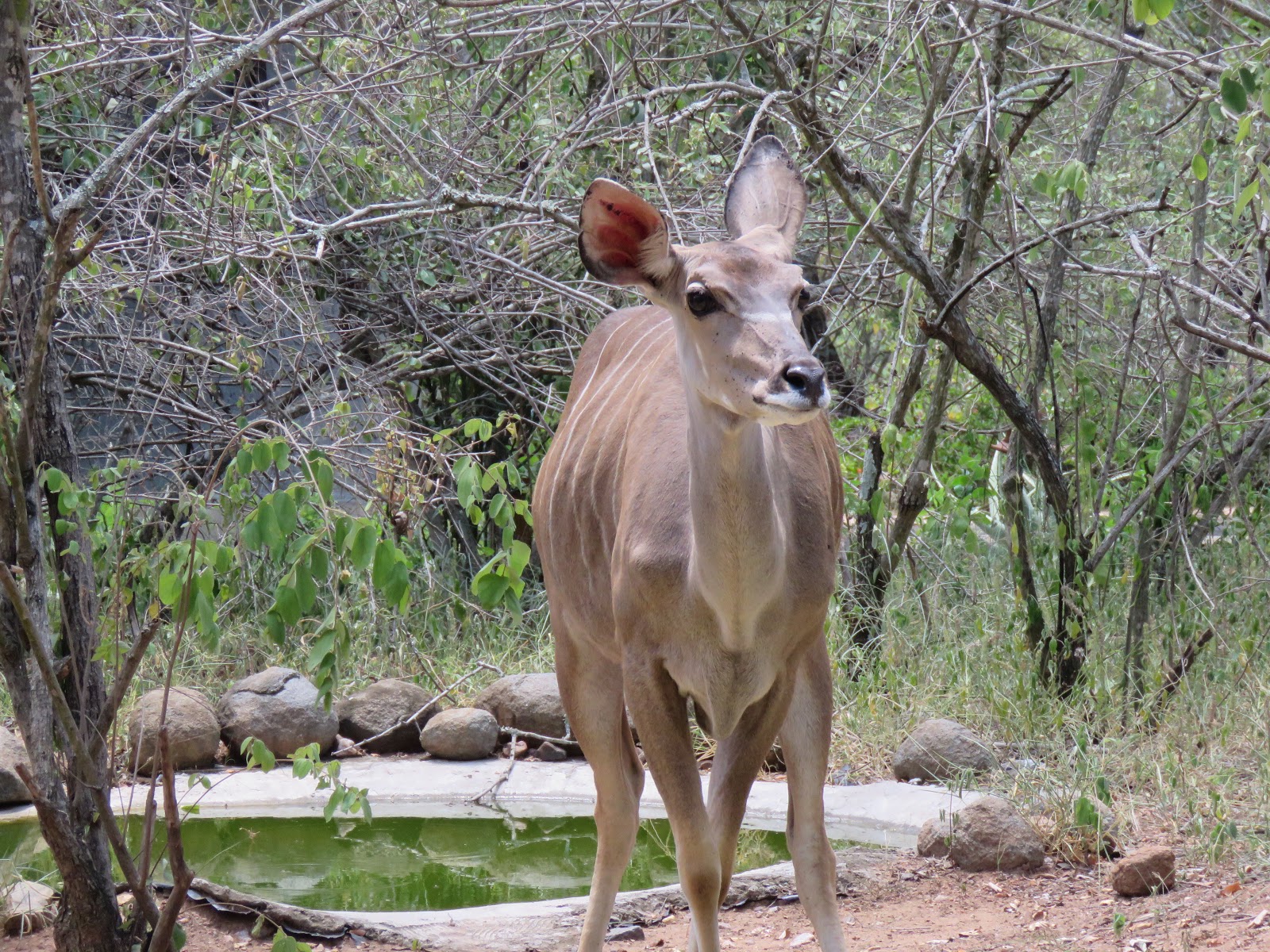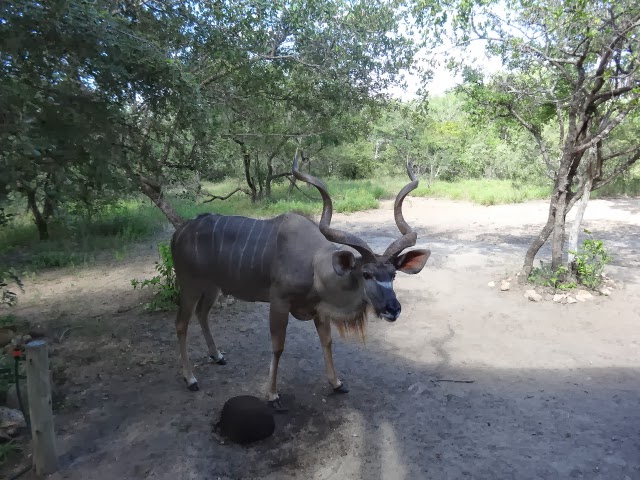“Sighting of the Day in the Bush”
 |
| Finally, my favorite, warthogs, stopped by for a lengthy visit—more on this tomorrow. |
I don’t know where to begin first, the outrageous sighting in the yard shortly after our friends arrived for dinner, a stunning sighting for all of us or, the exceptional evening we spent with four of our friends.
 |
||
Ken, Tom, and Don are making big faces for the camera!
|
 |
| At first, we only saw a few of the mongooses, but the rest were on their way into the yard. |
We only arrived a week ago today, and yet we’ve seen every species that resides in the Conservancy, and beginning next week, we’ll head to Kruger National Park hoping to see the Big Five once again; lion, elephant, cape buffalo, rhino, and leopard.
Our guests arrived promptly at 6:00 pm, and we were ready for our guests. When we’d made the invitation to the four of them for dinner, we realized we had enough food on hand for the meal without the necessity of heading to the market.
 |
| “Mongoose is the popular English name for 29 of the 34 species in the 14 genera of the family Herpestidae, small feliform carnivorans native to southern Eurasia and mainland Africa. The other five species (all African) in the family are the four kusimanses in the genus Crossarchus and the only species in the genus Suricata: Suricata suricatta, commonly called meerkat in English.” |
We made the following (all the meats were cooked on the grill):
1. Pork Chops
2. Lamb Chops
3. Boerewors (sausages) – “The many varieties of boerewors include specialties such as garlic wors, kameeldoring (camel thorn), Karoowors (sausage from the Karoo region in South Africa), and spekwors (made with extra cubed pork fat). Other ingredients include cheese and chili peppers.”
4. Cauliflower Mash
5. Pureed Pumpkin
6. Sauteed onions, garlic, and portabella mushroom (to top the seasoned meat)
7. Cabbage Salad
 |
| Suddenly a baby was on the scene. |
We’d purchased beer and wine, but they insisted on bringing their own beverages, a tradition when visiting guests in the bush. We had purchased a lighter red wine for me with less alcohol and tannins, which tend to keep me awake at night after a few glasses. It wasn’t as good as a regular Cabernet or Merlot, but I drank it anyway. Tom had Castle Beer, manufactured in South Africa and a local favorite.
 |
| Mongooses love raw eggs. When we spotted them, Tom ran inside, bringing out an 18 pack of fresh eggs. He laid one on the ground, and this is what happened. |
Although we’d seen Linda and Ken in Sydney 11 months ago, we hadn’t seen Kathy and Don in four years. It was Kathy and Don who’d invited us for Christmas Eve when they’d never met us. We’d met their mutual friends, Lynne and Mick, at Jabula Lodge a few days before Christmas, and they hooked us up.
 |
| During the period of time they were in our yard, Tom placed four eggs on the ground for them to quickly fight for and devour. It was quite a scene. |
Lynne and Mick were leaving Marloth for the holidays but wanted to make sure we had something wonderful to do on Christmas Eve. And indeed we did, spending the evening at Kathy and Don’s beautiful bush house bordering the Crocodile River. Here’s the link to that story.
To know that soon we’ll all be together again (also with other dear friends) at my birthday party in two days fills my heart with so much joy and love. How did we get so lucky?
 |
| Once the rest of them realized we had eggs, they piled atop one another. |
The evening flowed with considerable ease when we’d prepared all but the meat in advance. I heated the side dishes in the microwave and then popped them in the preheated oven. With the homemade dressing ready to go, I tossed the salad.
 |
|
“Mongooses live in southern Asia, Africa, and southern Europe, as well as Fiji, Puerto Rico, and some in the Caribbean and Hawaiian islands, where they are an introduced species. The 34 species range from 24 to 58 cm (9.4 to 22.8 in) in length, excluding the tail. Mongooses range in weight from the common dwarf mongoose, at 320 g (11 oz), to the cat-sized white-tailed mongoose, at 5 kg (11 lb).”
|
Tom, Don, and Ken fussed over the grill, and by 8:00 pm, we were all seated at the outdoor table, meats cooked to perfection, and we dug in for a hearty meal (minus gluten, grains, starch, and sugar). No one even noticed we didn’t have rice, potatoes, or bread.
The lively conversation continued through the delightful evening. We all have so much in common in our love for Marloth Park, traveling and being engaged in lively and exciting times at this point in our lives.
 |
| In a split second, they were all over the eggs. See our above video for details. “Mongooses mostly feed on insects, crabs, earthworms, lizards, birds, and rodents. However, they also eat eggs and carrion. The Indian gray mongoose and others are well known for fighting and killing venomous snakes, particularly cobras. They are adept at such tasks due to their agility, thick coats, and specialized acetylcholine receptors that render them resistant or immune to snake venom. However, they typically avoid the cobra and have no particular affinity for consuming its meat.” |
So yesterday, enriched by our friend’s visit and the many wildlife “visitors,” it was quite a special day. You won’t be disappointed! Enjoy our photos, and please take a moment to watch the video.
Be well. Be happy.
Photo from one year ago today, February 18, 2017:
 |
| Although overcast in the Huon Valley, Tom had a great day fishing and taking photos while boating with Anne and Rob. For more photos, please click here. |































